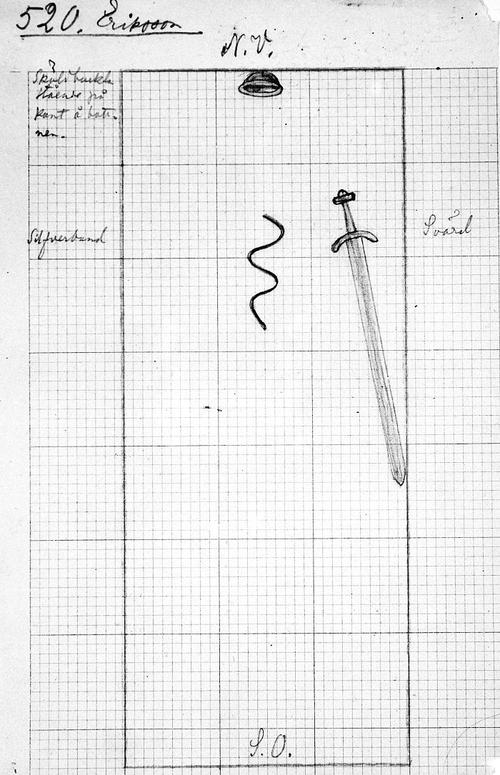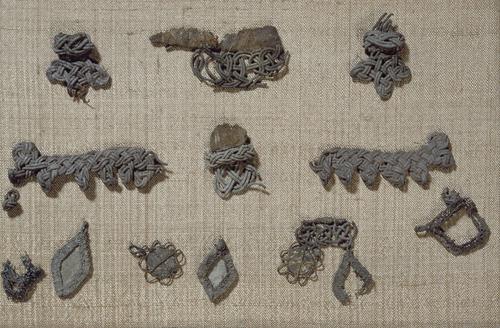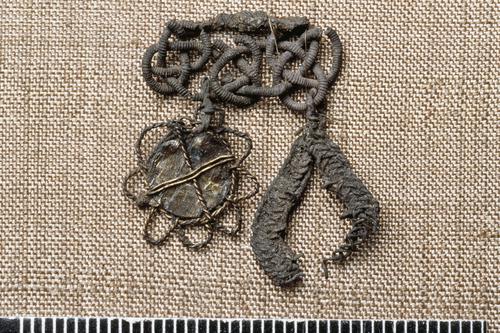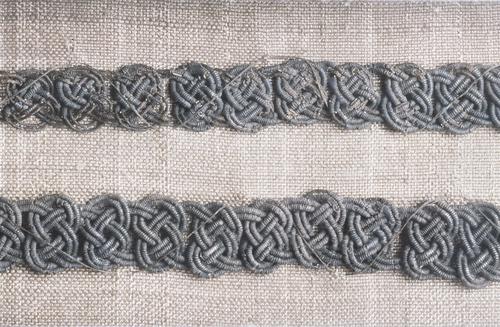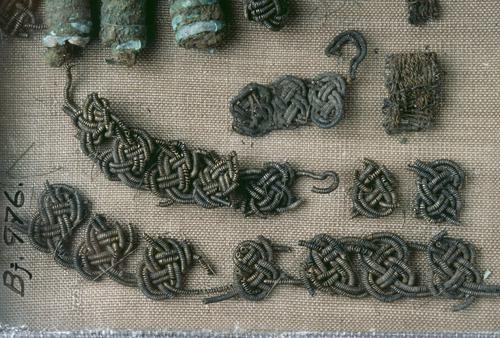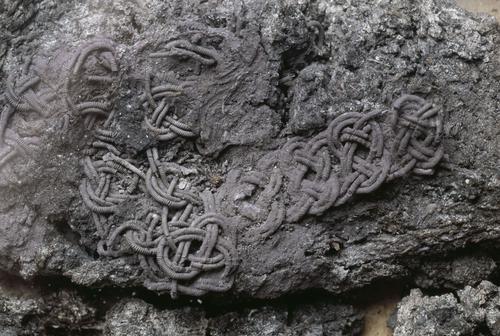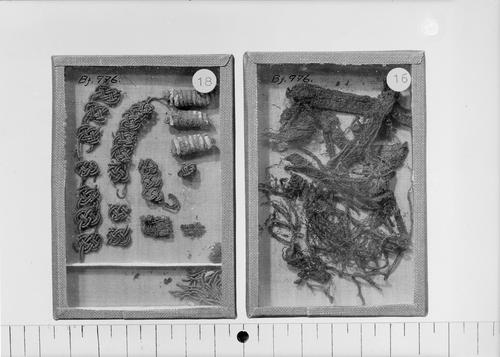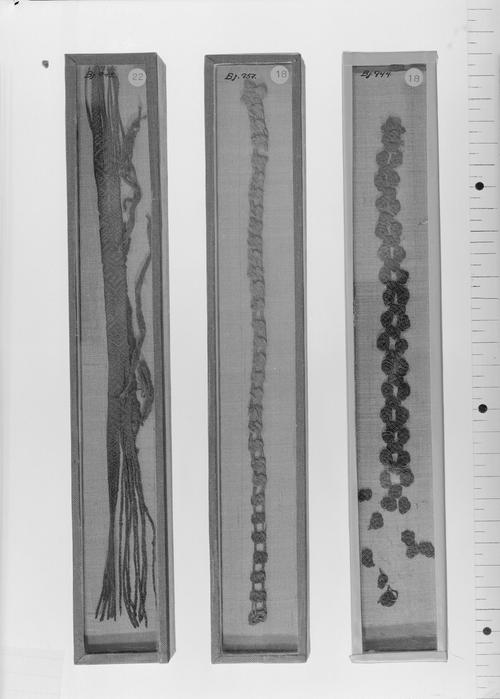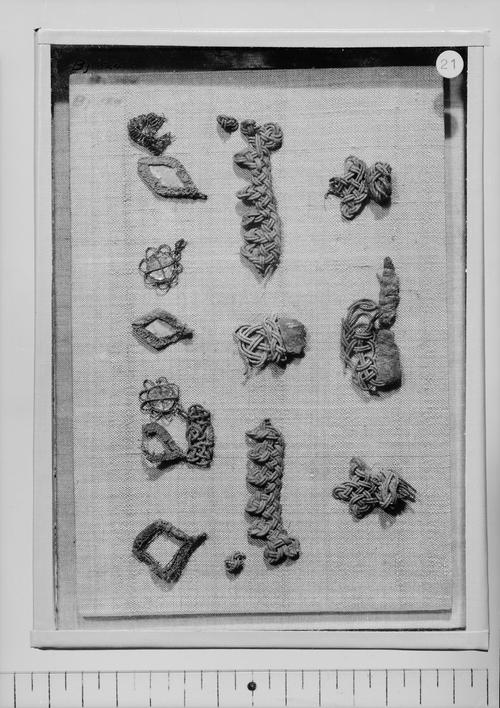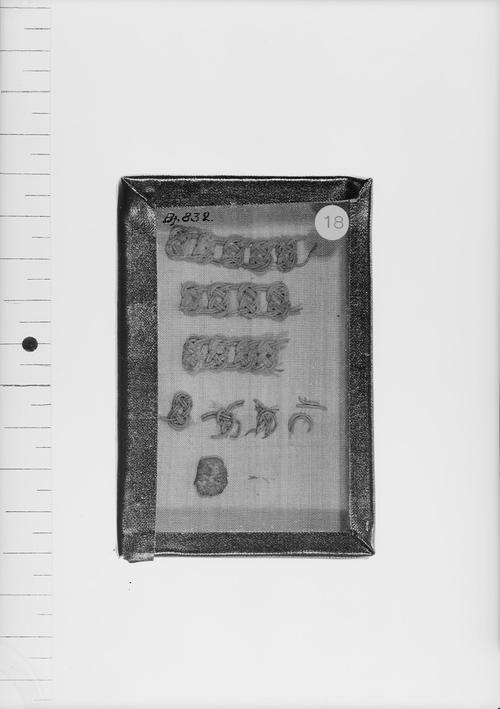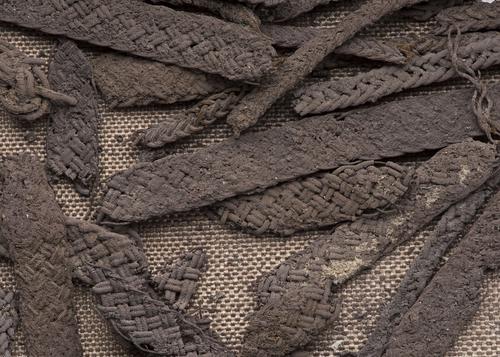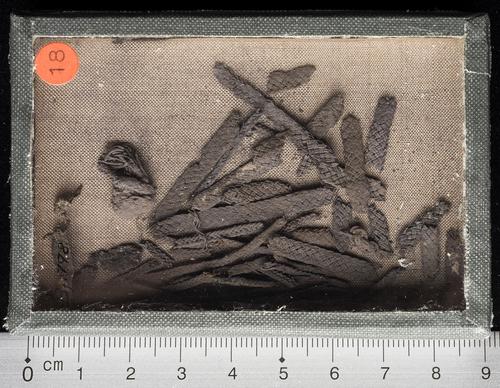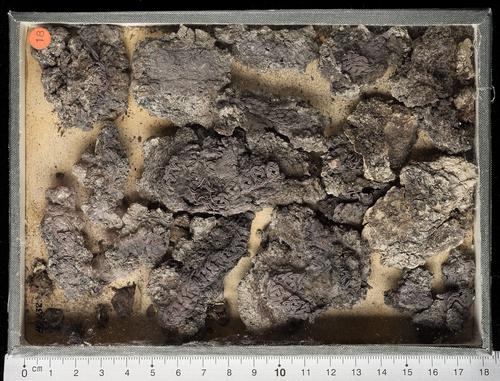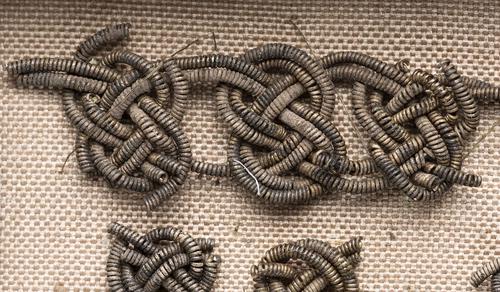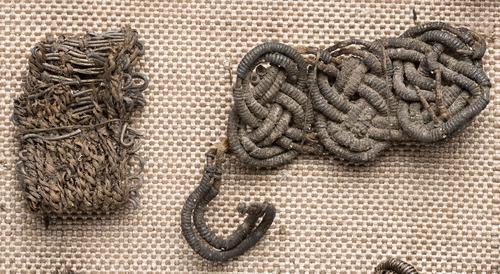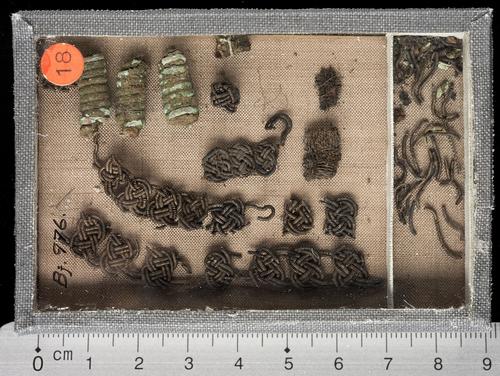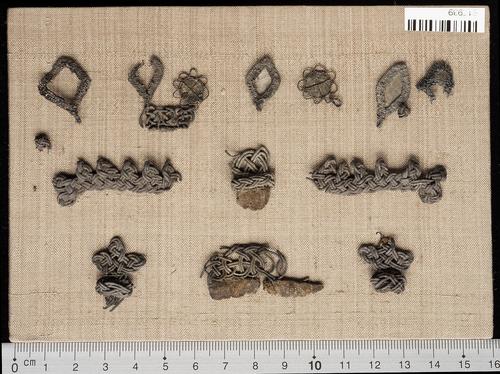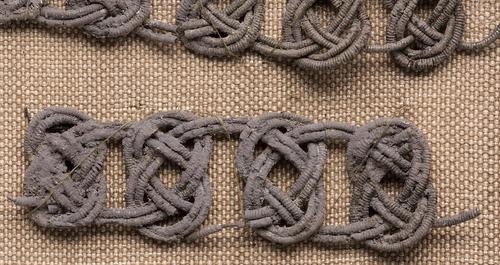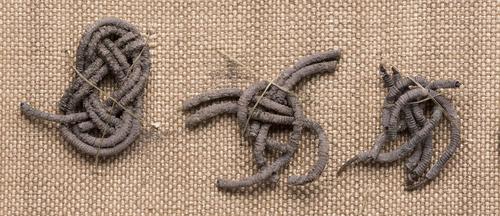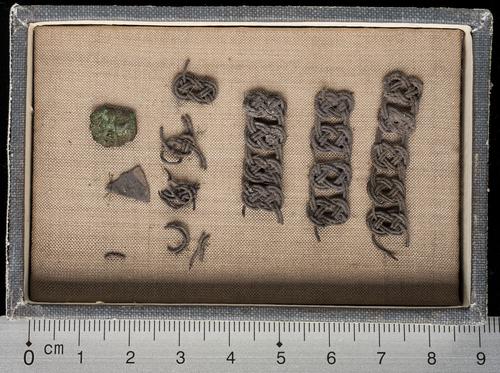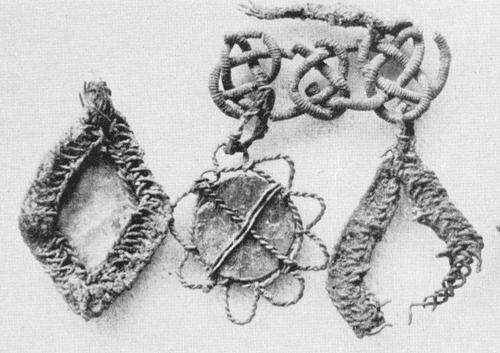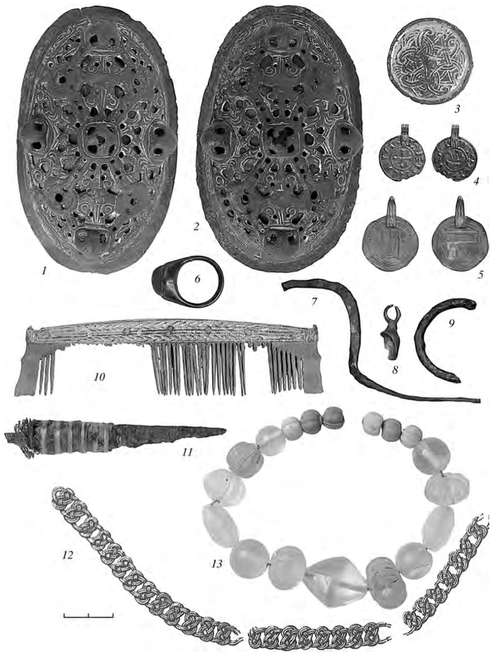P10
Spiral silver trim made from 8-shaped knots
Texts
Source texts referencing P10
Original text (DE):
P 10 a. 10 a. GRAB 520. Taf. 26:4. Knötchenborte, bestehend aus achterförmigen Zierknoten (Abb. 21 g) aneinander geknüpft. Doppelter Spiralsilberfaden, der Seidenkern teilweise erhalten. Breite 7 mm. Gesamtlänge ca. 90 cm.
English translation (AI generated):
P 10 a. 10 a. GRAVE 520. Plate 26:4. Knot border, consisting of figure-eight shaped decorative knots (Fig. 21 g) tied together. Double spiral silver thread, the silk core partially preserved. Width 7 mm. Total length approx. 90 cm.
Source texts referencing P10
Original text (DE):
P 10 b. GRAB 957. Taf 27: 6. Knötchenborte gleich der vorhergehenden, jedoch mit schütter verteilten Knoten. An dem einen Ende, wahrscheinlich dem Anfang der Arbeit, ein dreizipfliger Knoten, gleich P 23. Länge 24 cm, scheint vollständig zu sein.
English translation (AI generated):
P 10 b. GRAVE 957. Plate 27: 6. Knot border similar to the preceding one, but with sparsely distributed knots. At one end, probably the beginning of the work, a three-pronged knot, similar to P 23. Length 24 cm, appears to be complete.
Source texts referencing P10
Original text (DE):
P 10 c. GRAB 832. Taf 26: 5. Knötchenborten gleich den beiden vorhergehenden. Zusammengeknüllt in Erdklumpen und stark oxydiert. Kommt ausserdem in den Gräbern 427, 524 (vgl. St 28) und 976 vor.
English translation (AI generated):
P 10 c. GRAVE 832. Plate 26: 5. Knot borders similar to the two preceding ones. Crumpled in clumps of earth and heavily oxidized. Also appears in graves 427, 524 (cf. St 28) and 976.
Source texts referencing P10
Original text (DE):
GRAB 520. M. Silberne Knötchenborte, P 10, ungef. 90 cm lang, lag mitten im Grab in weichen S-förmigen Krümmungen. Im übr. nur Schwert und Schildbuckel. Die beiden Endzierate P 20 auf dem Plan nicht angegeben.
English translation (AI generated):
GRAVE 520. Male. Silver small knot border, P 10, approx. 90 cm long, lay in the middle of the grave in soft S-shaped curves. Otherwise only sword and shield boss. The two end ornaments P 20 not indicated on the plan.
Source texts referencing P10
Original text (DE):
GRAB 798. M. Um 900. Unbedeutende Reste eines silbernen Brettchenbandes, einige Stücke von Knötchenborten gleich P 10, 2 Sorten schmale, geflochtene Silberschnüre, P 1 u. 2. Die letzten bildeten eine breite Borte rings um die Stirne und das Hinterhaupt.
English translation (AI generated):
GRAVE 798. Male. Around 900. Insignificant remains of a silver tablet-woven band, some pieces of small knot borders similar to P 10, 2 types of narrow, braided silver cords, P 1 and 2. The latter formed a wide border around the forehead and the back of the head.
Source texts referencing P10
Original text (DE):
GRAB 832. M. Wahrsch. um 900. Auf dem Plan (Skelett vernichtet) sind auf beiden Seiten der grossen Ringnadel (ungef. auf den Schultern) zwei identische Figuren in der Form eines A gezeichnet. Weiter oben (über dem Kopf oder am Hals) eine Reihe kleiner Knoten in der Längsrichtung. Diese Bänder sind wahrscheinlich mit den Knötchenborten aus Spiralsilber, P 10 u. P 12, zu identifizieren, die jetzt in bedeutenden Mengen zusammengeknittert in Erdklumpen liegen. Weiter unten, vielleicht am Gürtel, lag der Goldhirsch (St 16), und die „Flitter-Stickerei” St 26 nebst mehreren Glimmerstückchen. Zwischen diesen und dem Messer, woran der Silberknoten P 18 haftete, lief ein jetzt verschwundenes Band. Das auf dem Plan nicht eingezeichnete kleine Tier St 18 lag wahrscheinlich hier. Ein Klumpen enthielt Reste von Pelz.
English translation (AI generated):
GRAVE 832. M. Probably around 900. On the plan (skeleton destroyed), two identical A-shaped figures are drawn on both sides of the large ring pin (approximately on the shoulders). Further up (above the head or at the neck), a row of small knots in the longitudinal direction. These bands are probably to be identified with the knotted borders of spiral silver, P 10 and P 12, which now lie crumpled together in significant quantities in clumps of earth. Further down, perhaps at the belt, lay the gold deer (St 16), and the 'sequin embroidery' St 26 along with several pieces of mica. Between these and the knife, to which the silver knot P 18 was attached, ran a band that has now disappeared. The small animal St 18, not drawn on the plan, was probably located here. One clump contained remains of fur.
Source texts referencing P10
Original text (DE):
GRAB 957. M. Knötchenborte aus Silber, P 10, am einen Ende mit einem dreizipfligen Knoten schliessend — liegt auf dem Plan in einer geraden Linie über der Stirne. Mehrere sehr beschädigte Stücke von Brettchenbändern, 2 Breiten, gleich B 6-7, teilweise angenäht an Seide, S 4; auf dem Plan sind 4-5 Bänder dicht zusammen schräg über der Brust zu sehen.
English translation (AI generated):
GRAVE 957. M. Knotted border of silver, P 10, ending at one end with a three-pronged knot — lies on the plan in a straight line above the forehead. Several heavily damaged pieces of tablet-woven bands, 2 widths, similar to B 6-7, partially sewn to silk, S 4; on the plan 4-5 bands are visible close together diagonally across the chest.
Source texts referencing P10
Original text (DE):
GRAB 976. M. Verworrene Reste von Silberband, ungef. B 7; Knötchenborte wie P 10 aus Silber, mindestens 15 cm. Gleitknoten aus Silber wie P 24. 3 Spiralen aus grobem Bronzedraht, wie Perlen auf eine Wollschnur aufgezogen, Masse ungef. 5 x 15 mm. — Auf dem Plan ist am Kopfende des Grabes eine S-ähnliche Figur aus dem Silberband, den Bronzespiralen und der Knötchenborte eingezeichnet.
English translation (AI generated):
GRAVE 976. M. Tangled remains of silver band, approximately B 7; knotted border like P 10 made of silver, at least 15 cm. Sliding knot of silver like P 24. 3 spirals of coarse bronze wire, strung like beads on a wool cord, dimensions approximately 5 x 15 mm. — On the plan, at the head end of the grave, an S-like figure made of the silver band, the bronze spirals, and the knotted border is drawn.
Source texts referencing P10
Original text (RU):
В камере обнаружен скелет женщины, лежащей на левом боку с согнутыми но- гами. В области груди – две овальные и одна круг- лая фибулы. На обратной стороне круглой фибулы – ушко для крепления железной цепочки, на кото- рой, по мнению авторов раскопок, висели односто- ронний костяной гребень с бронзовыми позоло- ченными накладками и, возможно, небольшой нож с рукояткой, обвитой тонкой серебряной прово- локой. На фаланге пальца правой руки (мизин- ца?) найден серебряный перстень с сердоликовой вставкой, на которой вырезана арабская надпись. В районе тазовых костей лежали 18 бус (12 – из горного хрусталя различной формы и размера, 6 – из глухого стекла желтого, голубого и зеленого цветов), бутылковидная подвеска, 2 монеты, пре- вращенные в подвески (дирхем и денарий), а также железные предметы в скоплении: обломок ключа от деревянного замка, четырехгранное массивное кольцо, фрагменты четырехгранного стержня (об- ломки иглы от скорлупообразной фибулы), оков- ки шкатулки с гвоздиками. На черепе и близ него обнаружены остатки металлизированной тесьмы – серебряные уточные нити со слабыми следами по- золоты. М.В. Фехнер предполагала, что это остатки тесьмы от головного убора, тканной на дощечках. На черепе и в районе груди зафиксированы следы тончайшей шелковой ткани полотняного перепле- тения, по реконструкции авторов раскопок при-крывавшей лицо и грудь покойной. В районе ног, с правой стороны от костяка – развалы двух лепных сосудов, нижняя часть челюсти свиньи и кость те- ленка
English translation :
The skeleton of a woman lying on her left side with her legs bent was found in the cell. Two oval and one round fibulae were found in the chest area. On the reverse side of the round fibula is an eye for attaching an iron chain, on which, according to the authors of the excavations, hung a single bone comb with bronze gilding and, possibly, a small knife with a handle wrapped in fine silver wire. A silver ring with a carved Arabic inscription and a cornelian inlay was found on a phalange of the right thumb (little finger?). In the area of the pelvic bones lie 18 beads (12 of rock crystal of varying shape and size, 6 of clear glass in yellow, blue and green), a bottle-shaped pendant, 2 coins converted into pendants (dirham and denarius) and iron objects in a cluster: a fragment of a key from a wooden lock, a tetrahedral solid ring, fragments of a tetrahedral rod (fragments of a needle from a shell-shaped fibula), the shackles of a casket with nails. The remains of a metallized braid, silver woolen threads with faint traces of gold, were discovered on and near the skull. M.V. Fechner suggested that these are the remains of a braid from a headdress, woven on planks. On the skull and in the area of the chest, there were traces of the finest silk cloth of linen weave, which, according to the authors of the excavations. The authors reconstructed that it covered the face and chest of the deceased. In the area of the legs, on the right side of the skeleton there were fragments of two stucco vessels, the lower part of a pig's jaw and a heifer's bone
